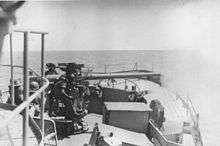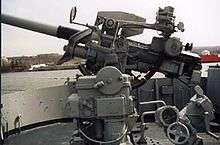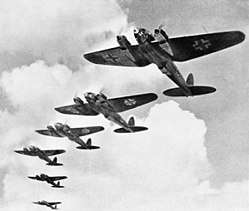3"/50 caliber gun
| 3-inch/50 caliber gun (Mk 22) | |
|---|---|
 | |
| Type | Naval gun |
| Place of origin | United States |
| Service history | |
| In service | 1890-1990s (US Navy) |
| Used by | US Navy |
| Production history | |
| Designed |
|
| Produced | 1900 – |
| Variants | Marks 2, 3, 5, 6, 8, 10, 17, 18, 19, 20, 21, and 22 |
| Specifications | |
| Weight |
|
| Length |
|
| Barrel length |
|
|
| |
| Shell | 24 lb (11 kg) armor-piercing, AA, VT Frag (Variable Timing Fragmentation), Illumination 13 lb (5.9 kg)[1] |
| Caliber | 3-inch (76 mm) |
| Elevation |
|
| Traverse | 360° |
| Rate of fire | 15 – 20 rounds per minute |
| Muzzle velocity | 2,700 ft/s (820 m/s) |
| Maximum firing range |
|
| Sights | Peep-site and Optical telescope |
The 3″/50 caliber gun (spoken "three-inch fifty-caliber") in United States naval gun terminology indicates the gun fired a projectile 3 inches (76 mm) in diameter, and the barrel was 50 calibers long (barrel length is 3 in × 50 = 150 in or 3.8 m). Different guns (identified by Mark numbers) of this caliber were used by the U.S. Navy and U.S. Coast Guard from 1890[1] through the 1990s on a variety of combatant and transport ship classes.
The gun is still in use with the Spanish Navy on Serviola-class patrol boats.
Early low-angle guns


The US Navy's first 3″/50 caliber gun (Mark 2) was an early model with a projectile velocity of 2,100 feet (640 m) per second. Low-angle (single-purpose/non anti-aircraft) mountings for this gun had a range of 7000 yards at the maximum elevation of 15 degrees. The gun entered service around 1900 with the Bainbridge-class destroyers, and was also fitted to Connecticut-class battleships. By World War II these guns were found only on a few Coast Guard cutters and Defensively Equipped Merchant Ships.[2]
Low-angle 3″/50 caliber guns (Marks 3, 5, 6, and 19) were originally mounted on ships built from the early 1900s through the early 1920s and were carried by submarines, auxiliaries, and merchant ships during the Second World War. These guns fired the same 2,700 feet (820 m) per second ammunition used by the following dual-purpose Marks, but with range limited by the maximum elevation of the mounting. These were built-up guns with a tube, partial-length jacket, hoop and vertical sliding breech block.[2]
Dual-purpose guns of the World Wars

Dual-purpose 3″/50 caliber guns (Marks 10, 17, 18, and 20) first entered service in 1915 as a refit to USS Texas (BB-35), and were subsequently mounted on many types of ships as the need for anti-aircraft protection was recognized. During World War II, they were the primary gun armament on destroyer escorts, patrol frigates, submarine chasers, minesweepers, some fleet submarines, and other auxiliary vessels, and were used as a secondary dual-purpose battery on some other types of ships, including some older battleships. They also replaced the original low-angle 4"/50 caliber guns (Mark 9) on "flush-deck" Wickes and Clemson-class destroyers to provide better anti-aircraft protection. The gun was also used on specialist destroyer conversions; the "AVD" seaplane tender conversions received two guns; the "APD" high-speed transports, "DM" minelayers, and "DMS" minesweeper conversions received three guns, and those retaining destroyer classification received six.[3]
These dual-purpose guns were "quick-firing", meaning that they used fixed ammunition, with powder case and projectile permanently attached, and handled as a single unit weighing 34 pounds (as opposed to older guns and/or heavier guns, in which the shell and powder are handled and loaded separately, which reduces the weight of each handled component, but slows the loading process). The shells alone weighed about 13 pounds including an explosive bursting charge of 0.81 pounds for anti-aircraft (AA) rounds or 1.27 pounds for High Capacity (HC) rounds, the remainder of the weight being the steel casing. Maximum range was 14,600 yards at 45 degrees elevation and ceiling was 29,800 feet (9,100 m) at 85 degrees elevation. Useful life expectancy was 4300 effective full charges (EFC) per barrel.[4]
Submarine deck guns
The 3"/50 caliber gun Marks 17 and 18 was first used as a submarine deck gun on R-class submarines launched in 1918-1919. At the time it was an improvement on the earlier 3"/23 caliber gun.[5] After using larger guns on many other submarines, the 3"/50 caliber gun Mark 21 was specified as the standard deck gun on the Porpoise- through Gato-class submarines launched in 1935-1942. The small gun was chosen to remove the temptation to engage enemy escort vessels on the surface.[6] The gun was initially mounted aft of the conning tower to reduce submerged drag, but early in World War II it was shifted to a forward position at the commanding officer's option. Wartime experience showed that larger guns were needed. This need was initially met by transferring 4"/50 caliber guns from S-class submarines as they were shifted from combat to training roles from late 1942. Later, the 5"/25 caliber gun, initially removed from battleships sunk or damaged in the attack on Pearl Harbor and later manufactured in a submarine version, became standard.[7]
Cold War anti-aircraft gun
When multiple hits from Oerlikon 20 mm cannon and Bofors 40 mm guns were unable to prevent kamikaze strikes during the final year of the second world war; the 3"/50 was adopted as a replacement for these weapons. Post-war experimentation with an extended range variant (3"/70 Mark 26 gun) was abandoned as shipboard surface-to-air missiles were developed. The United States Navy considered contemporary 5"/38 caliber guns and 5″/54 caliber guns more effective against surface targets.
_c1954.jpg)
The 3″/50 caliber gun (Mark 22) was a semiautomatic anti-aircraft weapon with a power driven automatic loader. These monobloc 3″ guns were fitted to both single and twin mountings. The single was to be exchanged for a twin 40 mm antiaircraft gun mount and the twin for a quadruple 40 mm mount. This was performed on Essex-class aircraft carriers, Allen M. Sumner and Gearing-class destroyers and other ships circa 1946-50. Although intended as a one-for-one replacement for the 40 mm mounts, the final version of the new 3-inch (76 mm) mounts was heavier than expected, and on most ships the mounts could be replaced only on a two-for-three basis. The mounts were of the dual purpose, open-base-ring type. The right and left gun assemblies were identical in the twin mounts. The mounts used a common power drive that could train at a rate of 30 degree/second and elevate from 15 degrees to 85 degrees at a rate of 24 degree/second. The cannon was fed automatically from an on-mount magazine which was replenished during action by two loaders on each side of the cannon.[8]
With proximity fuze and fire-control radar, a twin 3″/50 mount firing 50 rounds per minute per barrel was considered more effective than a quad Bofors 40 mm gun against subsonic aircraft,[9] but relatively ineffective against supersonic jets and cruise missiles. Destroyers that were modernized during the Fleet Rehabilitation and Modernization (FRAM) program of the 1960s had their 3-inch (76 mm) guns removed, but other ships retained them. In 1992, the 3″/50 caliber main battery on USCGC Storis was removed from the cutter. This was supposedly the last 3″/50 caliber gun in service aboard any US warship, but US Navy Charleston-class amphibious cargo ships retained their forward mounts until the last of the ships, USS El Paso (LKA-117) was decommissioned in 1994. The gun is still in service, however, on some warships of the Philippine Navy, including BRP Rajah Humabon, formerly USS Atherton.
The 17 Asheville-class gunboats mounted a single 3″/50 Mk 34 as their primary armament.
Ships mounting 3″/50 caliber guns
World War I:
- Bainbridge-class destroyers
- Chester-class cruisers
- Connecticut-class battleships
- Indiana-class battleships
- Mississippi-class battleships
- Nevada-class battleships
- New York-class battleships
- Paulding-class destroyers
- Pennsylvania-class battleships
- Pennsylvania-class cruisers
- R-class submarines
- St. Louis-class cruisers
- Smith-class destroyers
- South Carolina-class battleships
- Tennessee-class cruisers
- Truxtun-class destroyers
- Virginia-class battleships
World War II:
- Admirable-class minesweepers
- Buckley-class destroyer escorts
- Cachalot-class submarines
- Cannon-class destroyer escorts
- Doyen-class attack transport
- Edsall-class destroyer escorts
- Evarts-class destroyer escorts
- Gato-class submarines
- Mackerel-class submarines
- Omaha-class cruisers
- Porpoise-class submarines
- Salmon-class submarines
- Sargo-class submarines
- Tacoma-class frigates
- Tambor-class submarines
- Treasury-class cutters
Post–World War II:
- Des Moines-class cruisers (built with 10 twin mounts)[10]
- Worcester-class cruisers (built with 2 single and 11 twin mounts)[11]
- USS Juneau (CL-119) (refit with 7 twin mounts)
- Ashtabula-class oiler (built with 4 single mounts)[12]
- Midway-class aircraft carriers (refit up to 40 guns)[13]
- Essex-class aircraft carriers (refit up to 24 guns)[13]
- Baltimore-class cruisers (refit up to 20 guns)[14]
- Fletcher-class destroyers (refit up to 6 guns)
- Allen M. Sumner-class destroyers (refit up to 6 guns)
- Gearing-class destroyers (refit up to 6 guns)
- Terrebonne Parish-class tank landing ships (built with 3 twin mounts)[15]
- Denebola-class stores ships (built with 2 twin mounts)[16]
- Neosho-class fleet replenishment oilers (built with 4 or 6 twin mounts)[17]
- Dealey-class destroyer escorts (built with 1 twin and 2 single mounts)[18]
- Thomaston-class dock landing ships (built with 6 twin mounts)[19]
- Rigel-class stores ships (built with 2 twin mounts)[16]
- Forrest Sherman-class destroyers (built with 2 twin mounts)[20]
- USS Tulare (LKA-112) (built with 6 twin mounts)[21]
- Suribachi-class ammunition ships (built with 2 twin mounts)[22]
- De Soto County-class tank landing ships (built with 3 twin mounts)[15]
- Claud Jones-class destroyer escorts (built with 2 single mounts)[23]
- Coontz-class frigates (built with 2 twin mounts)[24]
- Iwo Jima-class amphibious assault ships (built with 4 twin mounts, some reduced to 2 mounts to provide space for missile launchers)[25]
- USS Bainbridge (CGN-25) (built with 2 twin mounts)[24]
- Leahy-class cruisers (built with 2 twin mounts)[24]
- Raleigh-class amphibious transport docks (built with 4 twin mounts)[26]
- Bronstein-class frigates (built with 1 twin and 1 single mount)[27]
- Mars-class combat stores ships (built with 4 twin mounts)[17]
- Simon Lake-class submarine tenders (built with 2 twin mounts)[28]
- Belknap-class cruisers (built with 2 single mounts)[24]
- Sacramento-class fast combat support ships (built with 4 twin mounts)[29]
- Austin-class amphibious transport docks (built with 4 twin mounts)[30]
- USS Truxtun (CGN-35) (built with 2 single mounts)[24]
- Guardian-class radar picket ships (converted from Liberty ships with 2 single mounts)[17]
- Charleston-class amphibious cargo ships (built with 4 twin mounts)[21]
- Kilauea-class ammunition ships (built with 4 twin mounts)[22]
- Wichita-class replenishment oilers (built with 4 twin mounts)[31]
- Anchorage-class dock landing ships (built with 4 twin mounts)[19]
- Newport-class tank landing ships (built with 2 twin mounts)[32]
- Blue Ridge-class command ships (built with 4 twin mounts)[33]
- Asheville-class gunboats (built with a single mount)
- St. Laurent-class destroyers (built originally with 2 Mark 33 twin mounts, later had one mount removed) (Canada)
- Restigouche-class destroyers (built with one Mark 33 twin mount aft, those refitted to the Improved Restigouche configuration had them removed) (Canada)
- Mackenzie-class destroyers (built with one Mark 33 twin mount aft except HMCS Qu'Appelle, which received two Mark 33 twin mounts [one forward, one aft]) (Canada)
- Annapolis-class destroyers (built with one Mark 33 twin mount forward) (Canada)
- HMCS Bonaventure (CVL 22) (built with 4 twin mounts, reduced to 2 during 1967 refit) (Canada)
See also

.jpg)

- Deck gun
Notes
- 1 2 DiGiulian
- 1 2 Campbell 1985 p.146
- ↑ Silverstone 1968 pp. 112, 212, 215, 276, 303
- ↑ Campbell 1985 p.145
- ↑ Gardiner & Gray, p. 130
- ↑ Friedman 1995, p. 193
- ↑ Friedman 1995, pp. 214-219
- ↑ "The Pouncer Challenges The Sub." Popular Mechanics, April 1955, pp. 88-93, see bottom of p. 90.
- ↑ USN Photographic Report 9163, 1948: The New Rapid Fire Navy 8'50 and 3'50 ( You Tube- US Salem Rapid Fire Guns)
- ↑ Albrecht 1969 p.320
- ↑ Albrecht 1969 p.323
- ↑ Blackman 1970 p.521
- 1 2 Friedman 1983, p. 221
- ↑ Albrecht 1969 pp.322-3
- 1 2 Blackman 1970 p.499
- 1 2 Blackman 1970 p.519
- 1 2 3 Blackman 1970 p.520
- ↑ Albrecht 1969 p.327
- 1 2 Blackman 1970 p.497
- ↑ Albrecht 1969 p.325
- 1 2 Blackman 1970 p.493
- 1 2 Blackman 1970 p.518
- ↑ Blackman 1970 p.457
- 1 2 3 4 5 Albrecht 1969 p.324
- ↑ Blackman 1970 p.492
- ↑ Blackman 1970 p.496
- ↑ Blackman 1970 p.456
- ↑ Blackman 1970 p.529
- ↑ Blackman 1970 p.522
- ↑ Blackman 1970 p.495
- ↑ Blackman 1970 p.523
- ↑ Blackman 1970 p.498
- ↑ Blackman 1970 p.490
References
- Albrecht, Gerhard (1969). Weyer's Warships of the World 1969. Annapolis, Md.: Naval Institute Press.
- Blackman, Raymond V. B. (1970). Jane's Fighting Ships 1970-71. Jane's Yearbooks.
- Campbell, John (1985). Naval Weapons of World War Two. Annapolis, Md.: Naval Institute Press. ISBN 0-87021-459-4.
- Friedman, Norman (1983). U.S. Aircraft Carriers: An Illustrated Design History. Annapolis, MD: Naval Institute Press. ISBN 0-87021-739-9.
- Friedman, Norman (1995). U.S. Submarines Through 1945: An Illustrated Design History. Annapolis, Md.: United States Naval Institute. ISBN 1-55750-263-3.
- Gardiner, Robert; Gray, Randal (1985). Conway's All the World's Fighting Ships, 1906-1921. London: Conway Maritime Press. ISBN 0-85177-245-5.
- Silverstone, Paul H. (1968). U.S. Warships of World War II. Doubleday and Company.
- DiGiulian, Tony, United States of America 3″/50 (7.62 cm) Marks 10, 17, 18, 19, 20, 21 and 22
External links
| Wikimedia Commons has media related to |
- USS Slater: 3 Inch / 50 Cal Gun (Mk 22) WARNING: Includes loud sounds
- Digiulian, Tony, Navweaps.com United States of America 3″/50 (7.62 cm) Marks 2, 3, 5, 6 and 8. British 3"/8cwt and 3"/17cwt
- DiGiulian, Tony, Navweaps.com United States of America 3"/50 (7.62 cm) Marks 10, 17, 18, 19, 20, 21 and 22
- DiGiulian, Tony, Navweaps.com United States of America 3"/50 (7.62 cm) Marks 27, 33 and 34